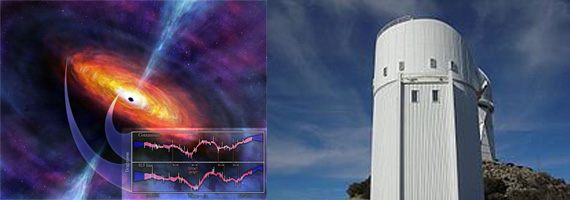
Masses of 44 Supermassive Black Holes Measured with the Help of the Bok Telescope
A collaboration of astronomers, including Steward's Ian McGreer and former Stewardites Jonathan Trump (PhD 2010), Pat Hall (PhD 1997), Brad Peterson (PhD 1978), Linhua Jiang (PhD 2008), and former postdoc Ran Wang, announced new measurements of the masses of a large sample of supermassive black holes far beyond the local Universe. Data came from the Sloan Digital Sky Survey, the CFHT telescope, and the Steward Observatory Bok telescope. The results, presented at the January 2018 American Astronomical Society (AAS) meeting in National Harbor, Maryland, are published in the Astrophysical Journal and represent a major step forward in our ability to measure supermassive black hole masses in large numbers of distant quasars and galaxies. Supermassive black holes are found at the centers of galaxies, and experience occasional bursts of activity when they accrete a large amount of gas from their surroundings. These phases are known as "quasars". Reverberation mapping is a technique that allows reliable estimates of the masses of the black holes powering quasars. Bright ultraviolet light is emitted from the gas very close to the black hole, and this light affects fast-moving, rotating gas farther away. By measuring the time between the variations in the ultraviolet light ("continuum") and the response (or "reverberation") to those variations from the rotating gas (the "line" emission), astronomers can obtain a distance between the two regions. Applying the basic laws of gravity then yields a mass for the black hole (see the left panel in the figure). This new result is the largest application of this method to date, with measurements reported for 44 black holes at much greater distances than previously measured.
The use of the Steward Bok telescope was key to improving the black hole mass measurements by providing more complete and accurate measurements of the time variations of the quasars' emission. Using the 15 year old 90Prime camera on the Bok 2.3 meter (90") telescope, the collaboration obtained measurements for 849 quasars spread over 60 different nights in 2014, and new measurements continue to come in today. The Bok data were obtained from a rotating cast of observers, including many UA undergraduate, graduate, and visiting students.
The full UA press release can be seen HERE. A CFHT press release can be found HERE.

For Public
Public events include our Monday Night Lecture Series, world-reknowned Astronomy Camp and Mt Lemmon Sky Center.

For Students
A good place to start if you want to become an undergrad major or grad student, or need to find our schedule of classes.

For Scientists
Find telescopes and instruments, telescope time applications, staff and mountain contacts, and faculty and staff scientific interests.




